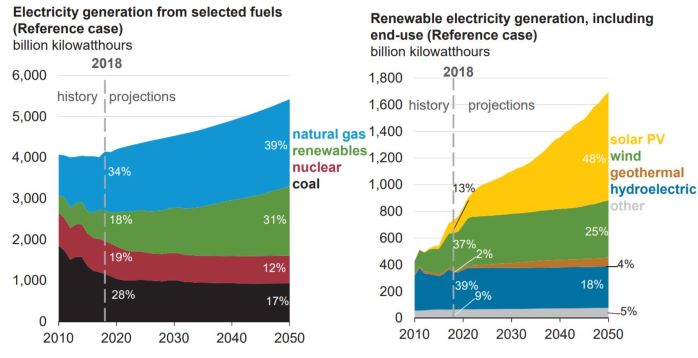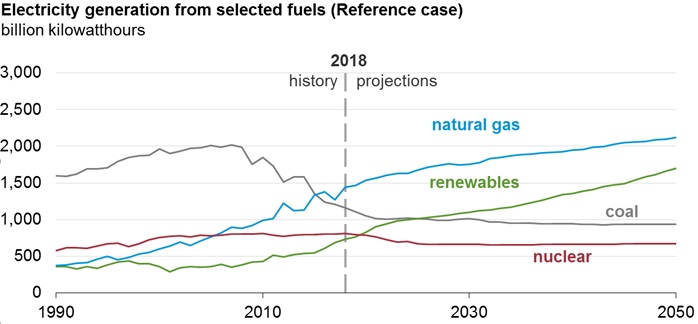

EIA’s Annual Energy Outlook 2019 maintains that in 2020, for the first time in almost 70 years, the United States will export more energy than it imports, and will remain a net energy exporter through 2050. U.S. energy export growth will be driven largely by petroleum exports including crude oil and products, and by additional liquefied natural gas exports. These trends have become clearly established after the recent administration push to open the Alaskan Arctic to oil and gas drilling as soon as possible.
In its reference case EIA also highlights the impact of sustained low natural gas prices and declining costs of renewables on the electricity generation fuel mix. Natural gas will maintain its leading share of electricity generation and continue to grow, increasing from 34% in 2018 to 39% in 2050. The renewables share, including hydro, also increases from 18% in 2018 to 31% in 2050, driven largely by growth in wind and solar generation.


“The AEO highlights the increasing role of renewable energy in the U.S. generation mix” said EIA Administrator Linda Capuano. “Solar and wind generation are driving much of the growth. In fact, our Reference case projects that renewables will grow to become a larger share of U.S. electric generation than nuclear and coal in less than a decade.”
[related_post]
Key takeaways:


The United States is expected become the largest producer of crude oil in the world, and growth in domestic oil, natural gas, and renewable energy production is quickly establishing the United States as a strong global energy producer for the foreseeable future” said EIA Administrator Linda Capuano. “For example, the United States produced almost 11 million barrels per day of crude oil in 2018, exceeding our previous 1970 record of 9.6 million barrels.”
At Iamrenew, we continue to believe that the long term projections for crude oil and other ground based reserves are fraught with uncertainty, especially as the effects of climate change manifest itself more sharply. A sharp escalation that can be linked clearly to climate change will lead to very fast changes , be it at state, or country level. Shale oil itself, remains an industry that has found a strong footing mostly in the US, and has struggled to expand elsewhere, due to local resistance as well as other challenges.
Industry’s like the auto industry are already showing visible signs of growth fatigue, and if the next big boom in public transport, especially in developing economies plays out, it could have a profound implication for global oil demand projections.
The first unit of the Compressed Biogas Plant built by Reliance at the Peddapuram Industrial…
As Karnataka gains momentum in the direction of ‘waste to energy,’ the Mysuru City Corporation…
DCM Shriram Limited has announced that it has successfully commissioned a new Compressed Biogas (CBG)…
TKIL Industries has partnered with global biogas conglomerate KIS Group to advance the production of…
1. What is Awite and what does it have to offer to the Indian biogas…
The Indian Federation of Green Energy (IFGE) and the Embassy of Nepal have jointly organized…